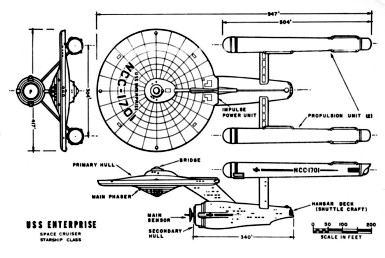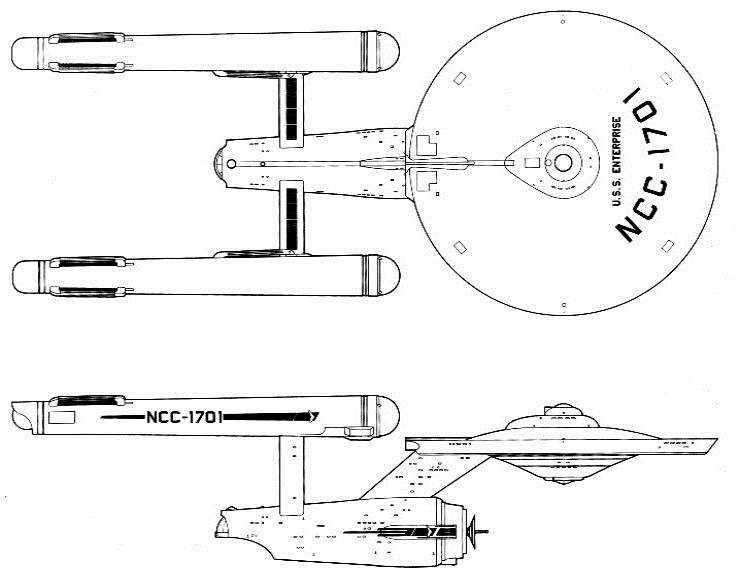




|
 Click for a larger image |
|
| A lot of these drawings more closely resemble the model kit than the actual studio model. For a drawing that accurately depicts the contours and details of the big model, I found the U.S.S. Essex (2257) in Ships of the Star Fleet, Vol. One, a fan-published listing of Star Trek era vessels. The image below is modified from that drawing. |

| The
color of the Enterprise
wasn't easy to pin down. As seen on TV,
it could vary from light gray to white to greenish or bluish-white
depending
on when during the show's run the footage was shot, the quality of the
print being viewed and the color settings of the viewer's TV set. Color stills of the Enterprise were limited to screen shots which were, at best, grainy or blurry and also subject to the color variations mentioned above. Information about the paint used on the model would change, depending on the source. I read an article by a "foremost authority" who said that it was GM gray auto primer right out of the can. I also heard from "someone who knew someone" that it could only have been Chrysler truck primer. Another foremost authority proclaimed that it was, without question Ford auto primer. The best available photos were from a series of black and white publicity stills taken during the show's production which showed the big model in great detail against a starry background. Prints of these photos were rare but could sometimes be found at Star Trek conventions and fan shops with an 8 x 10 print selling for $65 or more. (No.) Kalmbach books' Famous Spaceships of Fact and Fantasy . . . and How to Model Them has some nice black and white pics taken after Paramount Studios presented the big model to the Smithsonian Institution in the mid-1970s. There is also some interesting info about the model and useful tips on building the AMT kit, some of which were used for this project. Naturally, the best resource would be the Enterprise, itself. The Enterprise studio model is a popular attraction at the National Air and Space Museum. When I visited the museum in 1989, the big model was on display at the entrance to an exhibit about spaceflight in art, fiction and literature.
Sadly, the 25 year old Enterprise model was in poor condition. The paint looked like it was wearing away in a few places and most of the lights were out. Some parts which were damaged or missing when the Smithsonian acquired the model were replaced with parts that looked like they might have been scavenged from other models. The Enterprise looked less like the mighty starship seen on TV and more like the fragile, aging replica that it was.
Despite its condition, it was still exciting to see the big model on display. I must have taken about two dozen pictures. |
|
|
|
|
|
|
|
|
|
|
|
|
